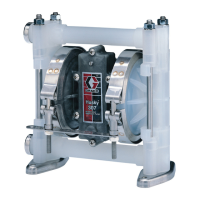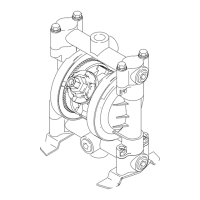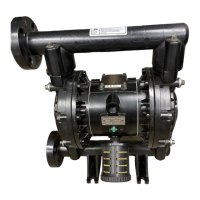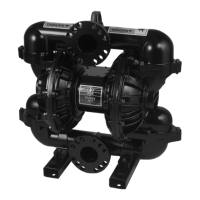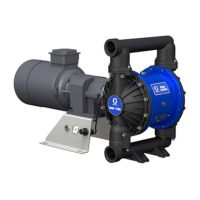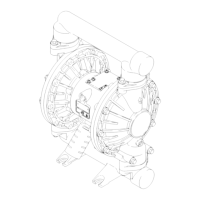12 308573
Maintenance
Lubrication
Do not lubricate the air line or air valve. Excessive
lubrication can cause the pump to malfunction.
Flushing and Storage
Flush the pump often enough to prevent the fluid you are
pumping from drying or freezing in the pump and
damaging it. Flush with a fluid that is compatible with the
fluid you are pumping and with the wetted parts in your
system. Check with your fluid manufacturer or supplier for
recommended flushing fluids and flushing frequency.
Always flush the pump and relieve the pressure before
storing it for any length of time.
Grounding Continuity Check
Check your system electrical continuity regularly to be
sure proper grounding is maintained.
Tightening Threaded Connections
Before each use, check all hoses for wear or damage, and
replace as necessary. Check to be sure all threaded
connections are tight and leak–free.
Check fasteners. Tighten or retorque as necessary.
Although pump use varies, a general guideline is to
retorque fasteners every two months. See Torque
Sequence, page 22.
Tightening the Clamps
When tightening the clamps (109), apply thread lubricant
to the bolts and be sure to torque the nuts (110) to 80 to
90 in–lb (9 to 10 N•m). See Torque Sequence, page 22.
See Fig. 7.
Apply thread lube to bolts and torque nuts to 80 to 90 in–lb (9 to
10 N•m). See Torque Sequence, page 22.
Fig. 7
Preventive Maintenance Schedule
Establish a preventive maintenance schedule, based on
the pump’s service history. This is especially important for
prevention of spills or leakage due to diaphragm failure.
WARNING
To reduce the risk of serious injury whenever you are
instructed to relieve pressure, always follow the
Pressure Relief Procedure on page 10.
1

